You’ll discover that transforming your small balcony into a thriving garden oasis isn’t about square footage—it’s about smart spatial planning. Whether you’re working with a 4’x6′ apartment terrace or a narrow 3’x10′ deck space, these eight proven optimization techniques can help you cultivate up to three times more plants than traditional layouts allow. Each method maximizes vertical space while maintaining accessibility, and you’ll soon learn how to implement these strategies for your specific outdoor area.
Contents
- 1 Vertical Garden Systems for Maximum Plant Coverage
- 2 Space-Saving Hanging Basket Arrangements
- 3 Multi-Tiered Plant Stands and Shelving
- 4 Railing-Mounted Planters and Window Boxes
- 5 Compact Container Gardens for Edible Plants
- 6 Living Wall Solutions for Small Balconies
- 7 Corner Plant Towers and Spiral Displays
- 8 Folding and Collapsible Plant Storage Ideas
Vertical Garden Systems for Maximum Plant Coverage
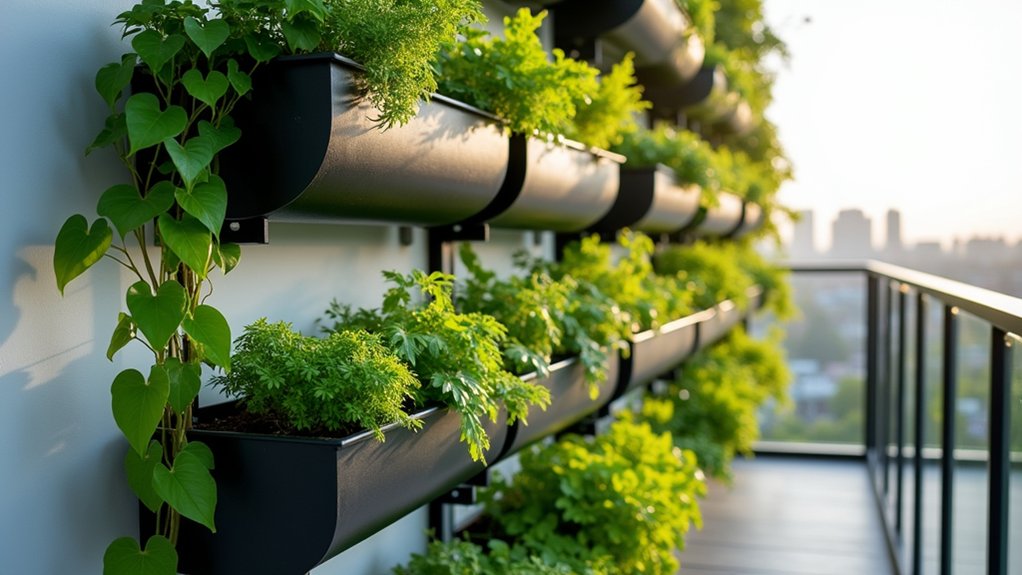
Vertical garden systems transform apartment balconies into lush, space-efficient plant displays by utilizing wall-mounted panels, pocket planters, or modular units that extend upward rather than outward.
These systems typically feature multiple tiers or compartments arranged vertically, allowing plants to grow at various heights while maximizing limited balcony square footage. Modern vertical gardens often incorporate built-in irrigation systems, moisture-retaining materials, and lightweight, durable construction materials like recycled plastic or powder-coated metal.
- Light requirements: Minimum 4-6 hours of direct or indirect sunlight, depending on plant selection
- Water needs: Regular watering schedule with efficient drainage system
- Soil type: Lightweight, well-draining potting mix enriched with organic matter
- Support structure: Strong mounting system rated for outdoor use
- Weight considerations: Maximum load capacity of 40-50 pounds per square foot
- Temperature range: 55-85°F (13-29°C) for most common vertical garden plants
Regular maintenance of vertical garden systems involves inspecting the mounting hardware monthly, pruning plants to prevent overcrowding, and checking irrigation systems for clogs or leaks.
Remove any dead or yellowing foliage promptly to prevent disease spread, and rotate plants seasonally to ensure even growth and prevent bare spots.
Fertilize with a balanced, water-soluble fertilizer during the growing season, and periodically clean the system’s components to prevent salt buildup and maintain proper drainage.
Space-Saving Hanging Basket Arrangements
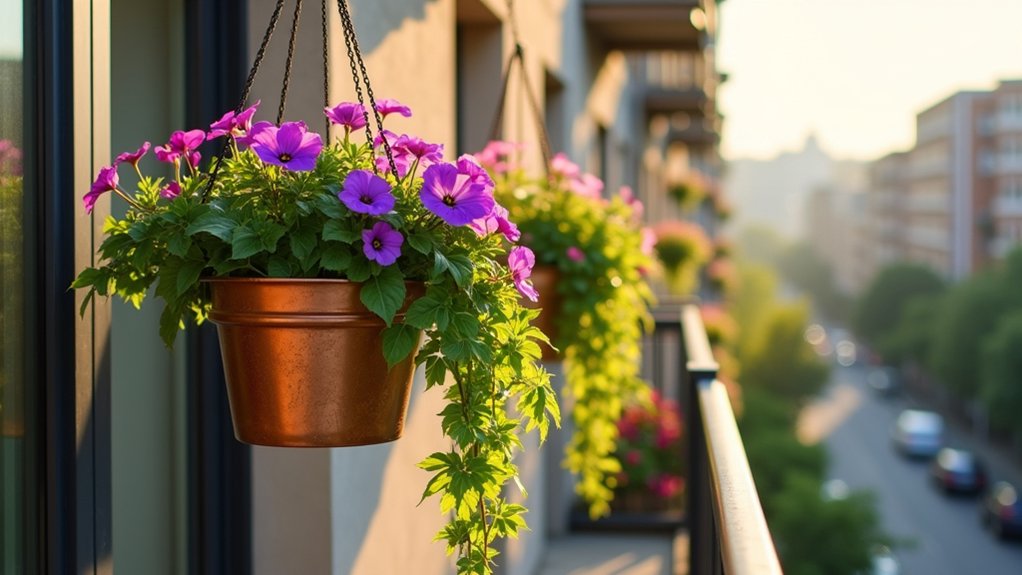
Space-saving hanging basket arrangements transform apartment balconies into vertical gardens, maximizing limited outdoor space through suspended planters that cascade with foliage and flowers.
These arrangements typically feature combinations of trailing plants like ivy, petunias, and fuchsias arranged in tiers or clustered at varying heights, creating a lush, dimensional display that draws the eye upward while keeping valuable floor space clear.
- Light Requirements: 4-6 hours of direct sunlight daily; morning sun preferred for most flowering varieties
- Water Needs: Check soil moisture daily; water thoroughly when top inch feels dry
- Soil Type: Well-draining potting mix with added perlite for improved aeration
- Container Specs: Hanging baskets with 12-16 inch diameter, equipped with drainage holes
- Temperature Range: 60-75°F (15-24°C) for optimal growth
- Humidity: Moderate to high, especially for tropical varieties
Regular maintenance of hanging basket arrangements involves pruning spent blooms and leggy growth to maintain shape and encourage bushiness.
Rotate baskets quarter-turns weekly to ensure even growth, and fertilize with a balanced, water-soluble fertilizer every two weeks during the growing season.
Check hanging hardware monthly for security, and replace deteriorating rope or chain supports before they compromise the safety of your arrangements.
Multi-Tiered Plant Stands and Shelving
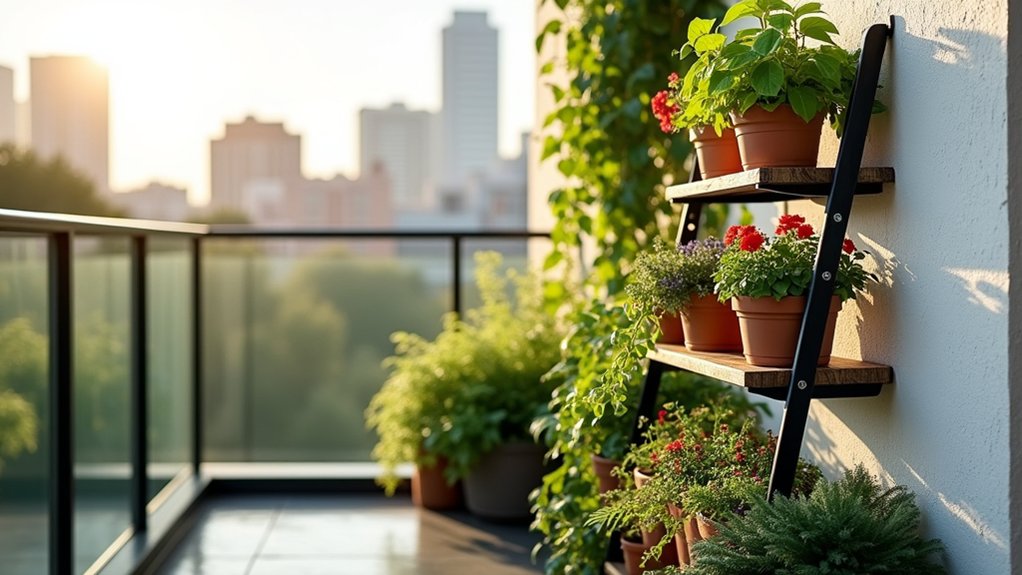
Multi-tiered plant stands and shelving systems offer a space-efficient vertical gardening solution for apartment balconies, featuring multiple levels that cascade upward to maximize growing area in a compact footprint.
These structures come in various materials like wood, metal, or bamboo, with designs ranging from ladder-style arrangements to spiral staircases, allowing plants to be displayed at different heights while creating visual interest and depth on the balcony.
- Position stands in areas that receive appropriate light based on plant needs, typically against a wall or railing.
- Ensure the structure is properly secured and weighted to prevent tipping from wind.
- Select stands with drainage holes or trays to manage water runoff.
- Choose weather-resistant materials suitable for outdoor exposure.
- Place sun-loving plants on upper tiers and shade-tolerant varieties on lower levels.
- Verify weight capacity of both the stand and balcony before loading with plants.
Regular maintenance of multi-tiered plant stands involves checking structural integrity, tightening loose components, and cleaning accumulated dirt or debris between levels.
Rotate plants periodically to ensure even growth and prevent overcrowding, and consider installing drip trays beneath each level to protect lower plants from excess water runoff.
During extreme weather, temporarily relocate portable stands indoors or secure them firmly to prevent damage from high winds.
Railing-Mounted Planters and Window Boxes
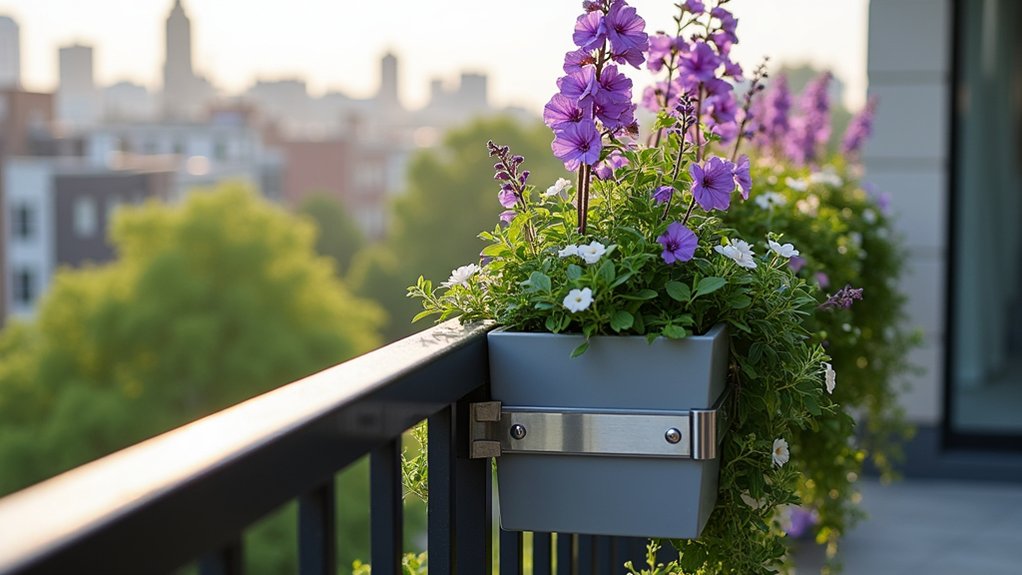
Railing-mounted planters and window boxes offer versatile growing solutions for balcony gardeners, maximizing limited space while adding visual interest to exterior walls and railings.
These containers typically feature sturdy mounting brackets or hooks that securely attach to railings or window sills, and come in various materials including plastic, metal, or weather-resistant composites.
Many models incorporate self-watering reservoirs and drainage systems to promote healthy root development while preventing water damage to building surfaces.
Growing Conditions:
- Mounting location requires sufficient stability and weight-bearing capacity
- Container depth should be at least 6-8 inches for most plants
- Well-draining potting mix specifically formulated for containers
- Light requirements vary by plant selection but generally need 4-6 hours of sun
- Water needs depend on exposure and climate; check soil moisture regularly
- Consider wind exposure when selecting plants and securing containers
Regular maintenance of railing-mounted planters and window boxes is crucial for both safety and plant health.
Inspect mounting hardware monthly for signs of rust or loosening, and tighten as needed.
Trim plants regularly to prevent them from becoming too heavy or unbalanced, which could strain the mounting system.
Clean drainage holes periodically to prevent clogging, and replace deteriorating containers before they become a safety hazard.
During winter months in cold climates, either empty containers or insulate them to prevent freeze damage to both plants and hardware.
Compact Container Gardens for Edible Plants
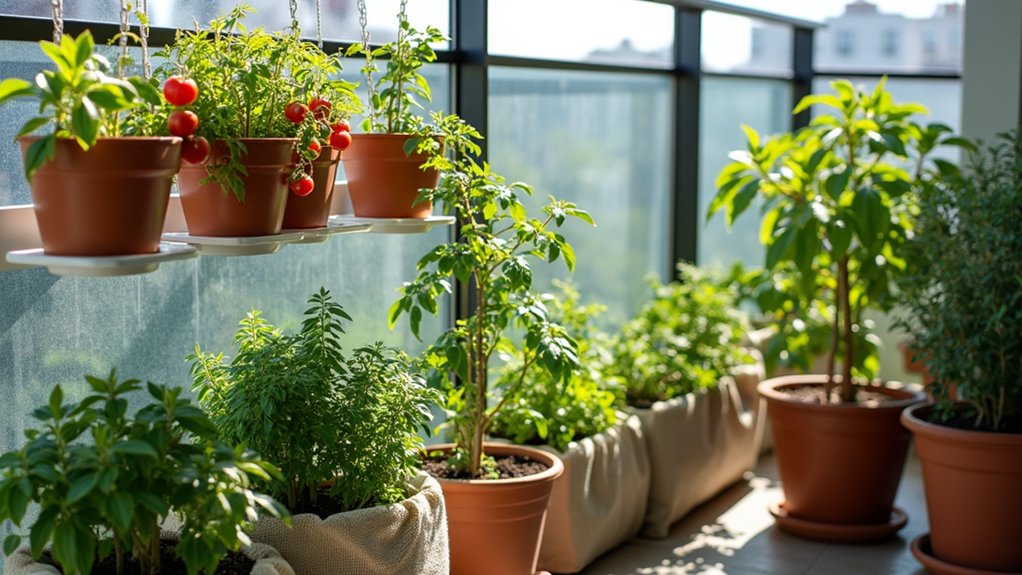
Compact container gardens for edible plants transform limited balcony space into productive mini farms through strategic placement of pots, vertical systems, and tiered planters.
These gardens typically feature a mix of herbs, leafy greens, dwarf vegetables, and compact fruit varieties arranged in space-saving configurations. Smart container combinations can include stackable planters, hanging baskets, railing planters, and wall-mounted systems that maximize growing area while maintaining accessibility for harvest and care.
- Light Requirements: 6-8 hours of direct sunlight daily; south or west-facing balconies ideal
- Water Needs: Consistent moisture; water when top inch of soil feels dry
- Container Size: Minimum 12 inches deep for most vegetables
- Soil Type: Well-draining potting mix enriched with compost
- Temperature Range: 60-80°F (15-27°C)
- Spacing: 2-3 plants per square foot depending on variety
- Container Material: Lightweight materials like plastic or fabric pots for easy handling
Regular maintenance of compact edible gardens involves pruning to control size, succession planting to ensure continuous harvests, and frequent fertilization due to the limited soil volume.
Monitor plants closely for signs of pest infestation or nutrient deficiencies, as container-grown plants are more vulnerable to these issues.
Rotate containers periodically to ensure even light exposure, and remove any dead or yellowing foliage to prevent disease spread in the confined growing space.
Living Wall Solutions for Small Balconies
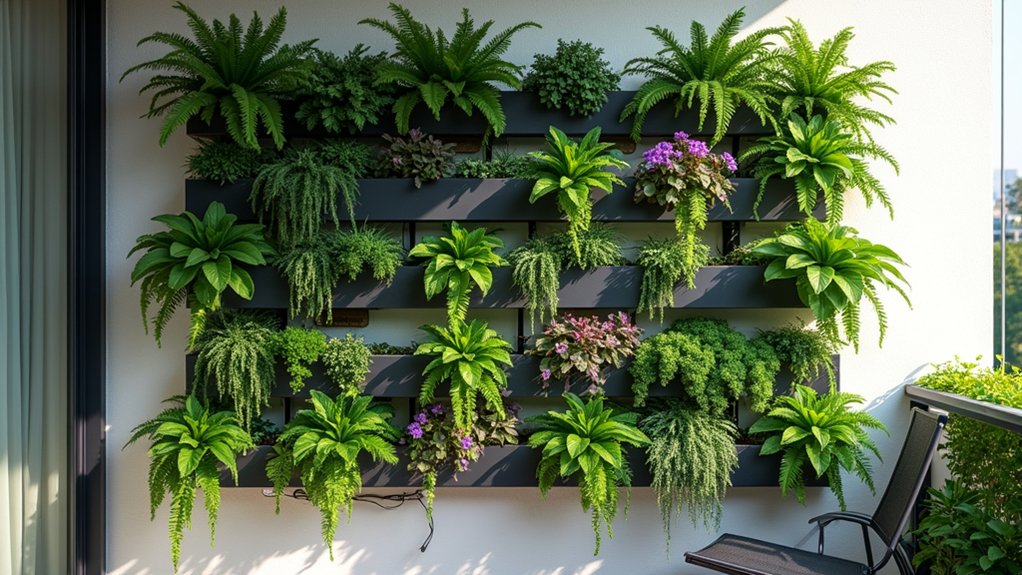
Living wall solutions transform small balcony spaces into vertical gardens by utilizing wall-mounted planters, pocket systems, or modular panels that allow plants to grow upward instead of outward.
These space-saving installations can feature a mix of ornamental and edible plants, creating a lush, green backdrop while maximizing limited floor space. The systems typically include multiple planting pockets or containers arranged in a grid pattern, often with built-in irrigation systems to ensure even water distribution.
Growing Conditions:
- Mounting location should be able to support the weight of the system and wet soil
- Wall should receive 4-6 hours of sunlight daily, with partial shade preferred in hot climates
- Well-draining potting mix specifically formulated for vertical gardens
- Plants should be selected based on the available light conditions and exposure
- Adequate airflow between plants to prevent fungal issues
- Installation should include a waterproof barrier to protect the wall structure
Regular inspection of the support structure, irrigation system, and individual plants forms the foundation of successful living wall maintenance.
Remove any dead or yellowing foliage promptly to prevent disease spread, and rotate plants seasonally to ensure even growth patterns.
Fertilize with a balanced, water-soluble fertilizer during the growing season, and check mounting hardware periodically to ensure the system remains securely fastened.
Trim plants to maintain desired shape and prevent overcrowding, which can lead to poor air circulation and plant health issues.
Corner Plant Towers and Spiral Displays
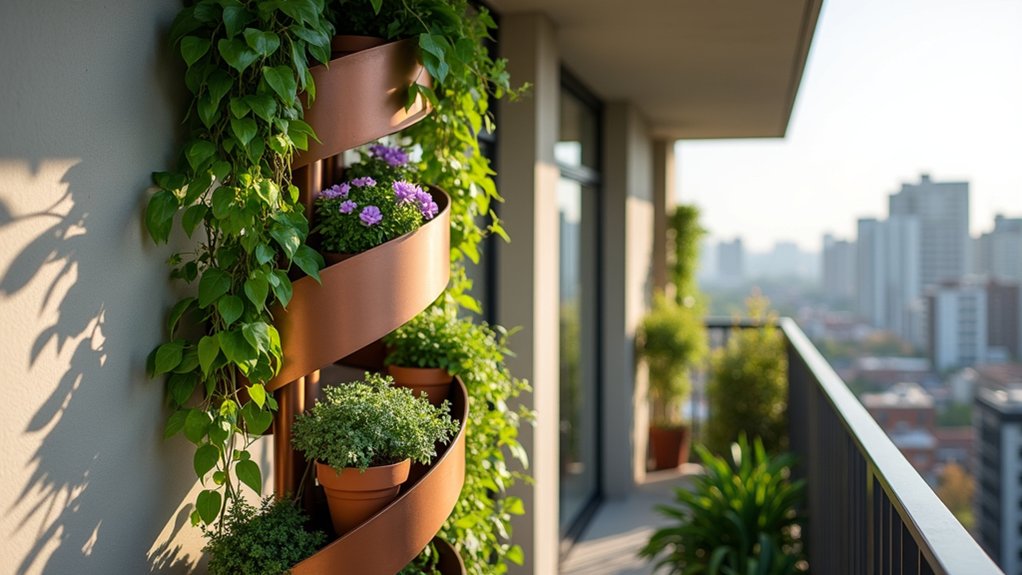
Corner plant towers and spiral displays transform unused balcony corners into stunning vertical gardens that maximize space while creating visual interest.
These structures typically feature graduated shelving or spiral-shaped stands that allow plants to be arranged in ascending heights, creating a dramatic architectural element. The design enables multiple plants to occupy a small footprint while ensuring each plant receives adequate light and air circulation, making them perfect for compact balcony spaces.
- Light Requirements: Best positioned in corners that receive 4-6 hours of direct sunlight, though specific placement depends on chosen plants
- Water Needs: Install with proper drainage system; bottom plants typically need more frequent watering due to runoff
- Soil Type: Well-draining potting mix suitable for container gardens
- Structure Support: Must be securely anchored to prevent toppling in wind
- Weight Considerations: Ensure balcony can support fully loaded tower weight
- Spacing: Allow 8-12 inches between plants depending on mature size
Regular maintenance involves rotating plants periodically to ensure even growth, as corner positions can sometimes result in uneven light exposure.
Inspect the support structure monthly for stability and signs of wear, particularly at connection points.
Prune plants to maintain the display’s shape and prevent larger specimens from overshadowing smaller ones, and clean any debris that collects between levels to prevent moisture buildup and potential pest issues.
Folding and Collapsible Plant Storage Ideas
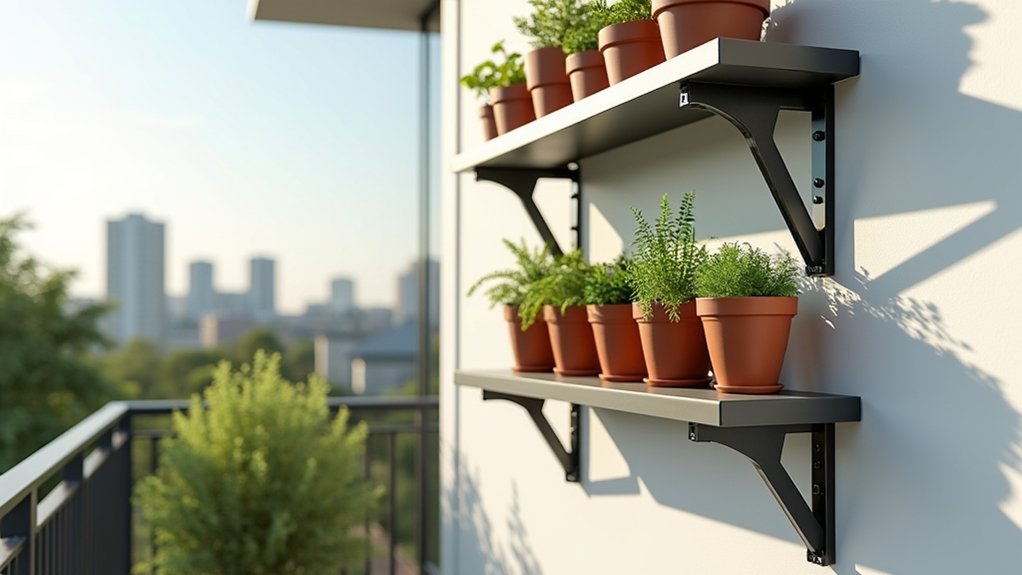
Folding and collapsible plant storage solutions offer space-saving versatility for apartment balcony gardening. These innovative systems typically include wall-mounted shelves that can be folded flat when not in use, tiered stands with collapsible levels, and hanging organizers that can be expanded or compressed as needed.
Many designs feature weather-resistant materials like powder-coated steel or treated wood, with some incorporating wheels for mobility and adjustable components to accommodate different plant sizes.
Storage System Requirements:
- Structural support capable of holding 15-25 pounds per shelf
- Weather-resistant materials for outdoor exposure
- Level surface for freestanding units
- Secure mounting points for wall-attached systems
- Adequate drainage holes or channels to prevent water pooling
- Non-slip surfaces or grips to keep pots stable
- Minimum 6 inches of clearance between levels for plant growth
Regular inspection of hinges, brackets, and other moving parts ensures these storage systems remain safe and functional.
Tighten any loose components promptly, and apply protective coatings or treatments annually to prevent rust or weather damage.
When rearranging plants, distribute weight evenly across shelves and platforms to maintain stability.
Clean surfaces regularly to prevent dirt buildup and potential pest issues, and check that drainage pathways remain clear to avoid water damage to both the structure and your plants.
